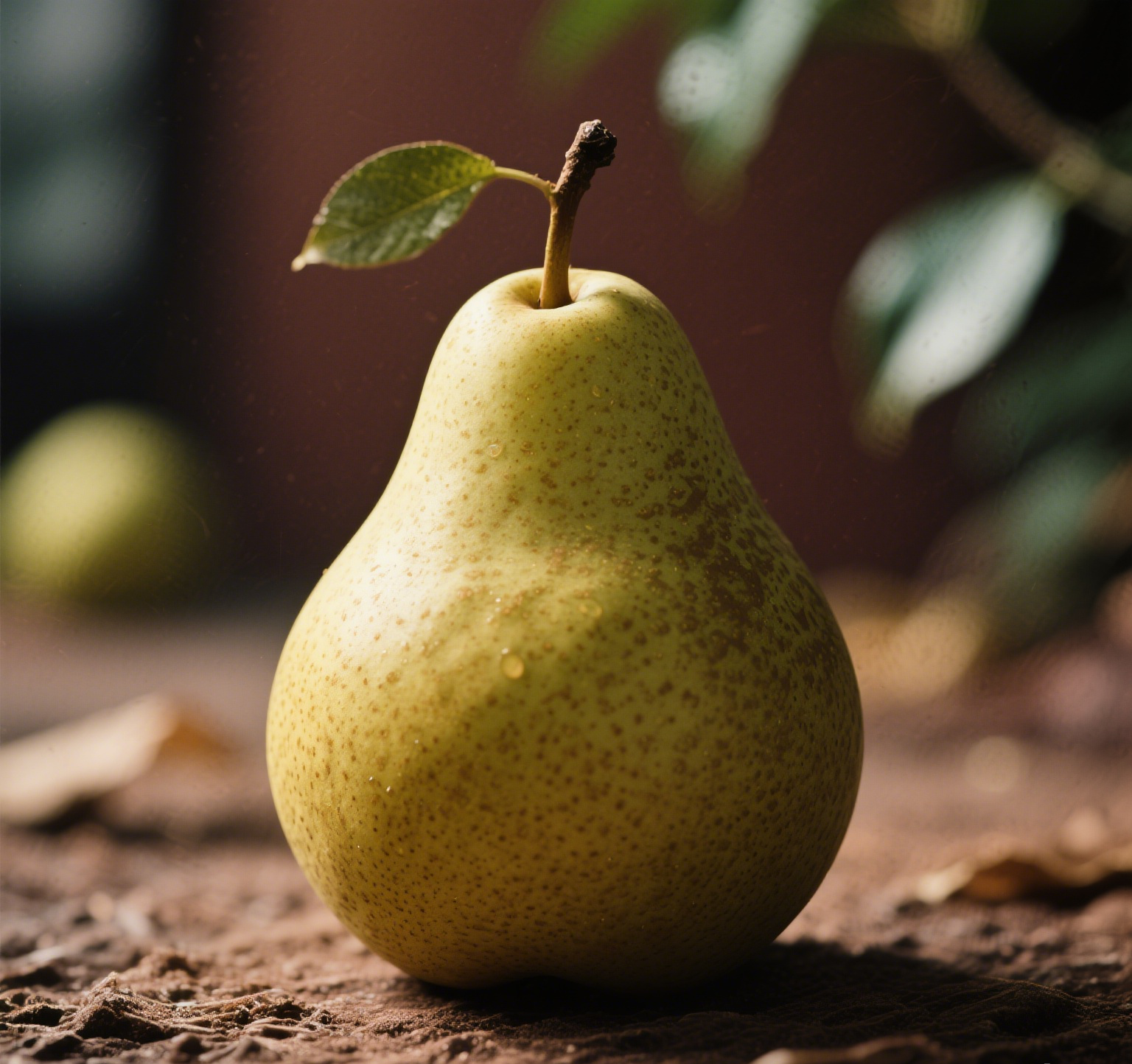Your Kitchen’s Unsung Hero with a Crunchy Twist
Imagine biting into a fruit that’s like nature’s water balloon—juicy, sweet, and so refreshing it makes your taste buds do the cha-cha. That’s the pear for you! Often overshadowed by flashier fruits like berries or avocados, pears are the humble rockstars of the produce aisle. If you’re a home cook whipping up meals for your family or a foodie always hunting for nutritious yet delicious ingredients, pears deserve a prime spot in your kitchen (and your diet). Let’s dive into the juicy details of why eating pears is like giving your body a high-five—with a side of crisp, fruity flavor.

Pears might look dainty, but don’t let their elegant curves fool you—these fruits are packed with nutrients. One medium pear (with the skin, because that’s where the magic happens) offers about 6 grams of fiber—that’s 21% of your daily needs! Fiber is the unsung hero of digestion, keeping your gut happy and your digestive system running smoother than a well-oiled pasta machine. It’s like a broom for your insides, sweeping away toxins and helping you feel full longer. Perfect for those days when you’re tempted to snack on the entire batch of cookies you just baked (we’ve all been there).
But wait, there’s more! Pears are also rich in vitamins C and K, plus potassium. Vitamin C is your immune system’s BFF, helping fight off those pesky colds that seem to strike right when you’re planning a fancy dinner party. Vitamin K? It’s like a personal trainer for your bones, keeping them strong and sturdy—ideal for all those times you’re lifting heavy cast-iron pans like a pro. And potassium? It helps regulate blood pressure, so you can stress less about life… or that soufflé that didn’t rise (it’s okay, add pear compote on top—it’ll be delicious).
Golden Rule: “A pear a day keeps the sugar cravings away”—okay, we tweaked that one, but with fiber and natural sweetness, it’s not far off!
Let’s get real—good digestion is the foundation of a happy life. Pears contain both soluble and insoluble fiber. Soluble fiber acts like a sponge, absorbing water and forming a gel-like substance that slows down digestion, helping regulate blood sugar and cholesterol. Insoluble fiber? Think of it as nature’s roughage, adding bulk to your stool and preventing… well, let’s just say “stomach traffic jams.” Together, they’re a dynamic duo that keeps your gut microbiome partying in harmony.
For home cooks, this means you can enjoy pears in all their forms—sliced in a salad, baked into a cozy tart, or even blended into a smooth soup—knowing they’re not just tasty but also working behind the scenes to keep your digestive system on track. No need for complicated “detox” diets when you can just add a pear to your lunch. Easy peasy,
lemon… wait, pear-y!
Life is full of stress—whether it’s burnt toast in the morning or a picky eater at the dinner table. Your body faces stress too, in the form of free radicals—unstable molecules that can damage cells and lead to aging and disease. Enter pears: their skin is loaded with antioxidants like flavonoids and polyphenols, which act like tiny bodyguards, neutralizing those harmful free radicals.
Ever noticed how a pear’s skin has that beautiful, speckled pattern? Those aren’t just freckles—they’re battle scars from nature’s antioxidant army! Eating the skin (yes, please don’t peel it unless a recipe calls for it) gives you the maximum dose of these protective compounds. So next time you’re prepping pears for a dessert, leave that skin on and tell your family it’s “nutritional camouflage.”
Pears are about 84% water—making them the ultimate hydrating fruit. In a world where we’re all reminded to “drink more water,” pears offer a delicious shortcut. Whether you’re sweating it out in a hot kitchen or just need a mid-afternoon pick-me-up, biting into a crisp pear is like taking a sip from a natural spring… with a hint of honeyed sweetness.
Hydration isn’t just about quenching thirst; it’s crucial for skin health, energy levels, and even brain function. So forget those sugary sports drinks—grab a pear instead. Your skin will thank you, your brain will thank you, and your taste buds will do a little happy dance. Plus, hydrated chefs are happy chefs, and happy chefs make better meals. It’s a win-win!
Let’s talk calories. A medium pear clocks in at around 100 calories—less than a small bag of chips but way more filling. Thanks to their high water and fiber content, pears help you feel satisfied without packing on the pounds. That’s great news if you’re trying to maintain a healthy weight or just want to enjoy dessert without the guilt.
Imagine this: instead of reaching for a sugary snack, you slice up a pear and top it with a dollop of Greek yogurt and a sprinkle of nuts. You get a creamy, crunchy treat that’s low in calories but high in flavor and nutrition. It’s like tricking your brain into thinking you’re indulging… but really, you’re being a wellness warrior. Chef’s kiss!
Now, let’s get to the fun part—cooking with pears! Home cooks love ingredients that are versatile, and pears are the Swiss Army knife of fruits. Here’s how they shine in the kitchen:
- Breakfast: Add pear slices to oatmeal, blend into a smoothie, or top your yogurt parfait.
- Lunch: Toss them into salads with arugula, blue cheese, and walnuts for a sweet-savory combo that’s restaurant-worthy.
- Dinner: Pair roasted pears with pork chops or chicken for a glaze that’s caramelized perfection.
- Dessert: Bake them into tarts, poach them in red wine for a fancy finish, or mash them into a pear-applesauce for the kids (or yourself—no judgment).
- Snack: Slice and dip in peanut butter, or freeze for a chilly, guilt-free treat.
Their mild, sweet flavor pairs well with everything from sharp cheeses to warm spices like cinnamon and cloves. Plus, they hold their shape when cooked, making them ideal for stuffing, grilling, or even charcuterie boards. The only limit is your imagination (and maybe how many pears you can fit in your fridge).
Your heart works hard every day, so why not give it some love back? The fiber, potassium, and antioxidants in pears all contribute to heart health. Fiber helps lower LDL cholesterol (“the bad kind”), while potassium balances sodium and keeps blood pressure in check. Antioxidants reduce inflammation, which is key for preventing heart disease.
Think of pears as a delicious way to say “thank you” to your heart. Whether you’re sautéing them for a fancy dinner or munching on them as a snack, you’re adding a heart-healthy ingredient to your menu. And let’s be real—anything that tastes good and is good for you is a kitchen superstar in our book.
Pears are not only good for you but also gentle on your budget. They’re widely available, especially during their peak seasons (fall and early winter), and come in many varieties—Bosc, Bartlett, Anjou, Comice—each with its own texture and flavor. Plus, they’re easy to store: keep them at room temperature to ripen, then pop them in the fridge to extend their shelf life. No fancy storage tricks needed!
From a sustainability standpoint, pears are often grown with fewer pesticides than other fruits, and their peel is edible, reducing waste. As a home cook, using every part of the fruit (yes, even the core, if you’re making compost!) makes them a eco-friendly choice. It’s a small way to contribute to a healthier planet while enjoying a healthier you.
In a world of superfoods that come with a side of hype, pears are the quiet overachievers. They’re nutritious, versatile, and delicious—whether you’re eating them raw, cooking them up, or sharing them with the family. They’re the fruit that says, “I’m here to support your health, make your meals tastier, and look good doing it.”
So, next time you’re at the grocery store, don’t walk past the pear section. Grab a few, bring them home, and let them work their magic. Your gut will thank you, your heart will thank you, and your taste buds? They’ll be too busy enjoying the sweetness to say anything.
Golden Nugget: “Life is short, eat the pear—especially when it’s baked into a buttery tart.”
Whether you’re a seasoned home cook or just starting out, pears are the ingredient that proves healthy eating doesn’t have to be boring. They’re a reminder that the best benefits come in simple, natural packages—with a satisfying crunch and a hint of honeyed goodness. So go ahead, embrace the pear power—your body (and your recipes) will be glad you did.

